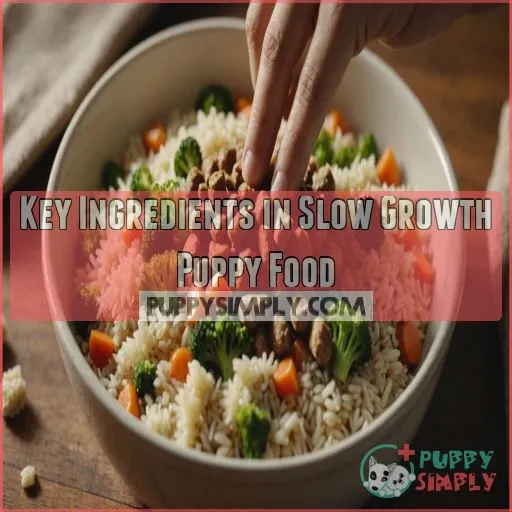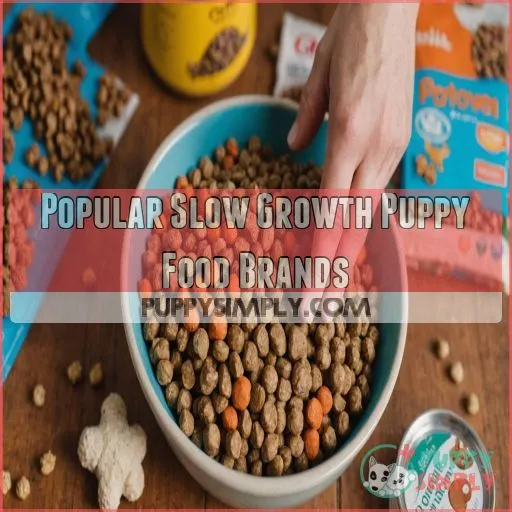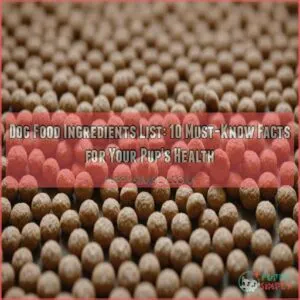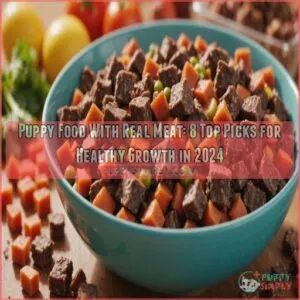This site is supported by our readers. We may earn a commission, at no cost to you, if you purchase through links.
 Slow growth puppy food formulas are like a pause button on your pup’s growth spurt, ensuring they don’t outgrow their skeletons.
Slow growth puppy food formulas are like a pause button on your pup’s growth spurt, ensuring they don’t outgrow their skeletons.
Picture large breed puppies as energetic construction zones: everything needs to progress just right to avoid structural risks later.
These formulas, rich in high-quality proteins and balanced nutrients, help prevent joint issues and obesity, keeping your puppy in tip-top shape.
While it’s tempting to hurry their growth, slow and steady wins this race. Think of it as building a solid foundation with no shortcuts.
Curious to know which brands top the list and how to get started? Stick around for more insights!
Table Of Contents
- Key Takeaways
- Choosing the Right Puppy Food
- Benefits of Slow Growth Puppy Food
- Key Ingredients in Slow Growth Puppy Food
- Popular Slow Growth Puppy Food Brands
- Feeding Schedule and Portion Control
- Health Risks Associated With Rapid Growth
- Working With Your Veterinarian
- Frequently Asked Questions (FAQs)
- How to slow down puppy growth?
- What can I feed my puppy for maximum growth?
- What causes slow growth in puppies?
- Does large breed puppy food slow growth?
- How do I transition my puppy to adult dog food?
- What are the signs of proper growth in a puppy?
- How does slow growth feeding affect a puppys final size?
- Can I use supplements with slow growth puppy food?
- What are the long-term benefits of slow growth feeding?
- Conclusion
Key Takeaways
- Taming the Growth Monster: Slow-growth puppy food is like hitting the brakes on the growth monster who’s ready to gallop. These formulas help your large-breed pup grow at a manageable pace, reducing risks of joint issues and ensuring a steady, healthy journey to adulthood.
- Nutrient Symphony: Think of your pup’s diet as a symphony where each nutrient plays its part. Balance is key—too much protein or calcium can cause disharmony—and ensuring the right mix keeps their bones and joints on track. This orchestrated approach saves you from unexpected health glitches.
- Avoiding The Buffet Binge: It’s tempting to let those puppy dog eyes lead you to overfeed, but holding the line with slow-growth formulas avoids obesity. Imagine managing their meals like tuning a fine instrument—portion control and regular weight checks keep your furry friend in tune with their growth needs.
- The Long Game Advantage: Remember, slow and steady wins the race! By opting for slow-growth feeding, you’re investing in your pup’s long-term health. It’s like building a house with a solid foundation; you’ll avoid future “renovations” from joint surgeries and health issues.
Choosing the Right Puppy Food
When choosing the right puppy food for your large breed, consider the important balance of nutrients that support healthy growth without fillers.
Don’t worry; you won’t need a Ph.D., just a little guidance on proteins, calcium, and phosphorus to keep your puppy bounding up to you every day.
Nutritional Considerations for Large Breed Puppies
When choosing the right puppy food, do you know what large breed puppies need? Their growing bodies require specific nutrients to support healthy development and prevent issues like skeletal abnormalities. Let’s take a closer look at the key considerations.
Large breed puppies need specific nutrition for healthy growth.
- Protein: Aim for 22-32% on a dry matter basis.
- Fat: Balanced between 10-25% on a dry matter basis.
- Carbohydrates: Approximately 20% on a dry matter basis.
- Supplements: Consult your vet before adding any extras.
Importance of Calcium and Phosphorus Content
Getting the calcium-phosphorus ratio just right in large-breed puppy food is essential for bone development and joint health.
Think of it as the Goldilocks balance for puppies—neither too high nor too low—to support their perfect growth rate and nutritional needs.
Protein and Fat Content for Optimal Growth
You’ve nailed calcium and phosphorus; it’s time to focus on protein and fat for puppy growth.
Think of it as a recipe for success:
- Protein boosts muscle growth.
- Fat offers energy.
- Keep it balanced for a steady growth rate!
Avoiding Fillers and By-Products
Just like you wouldn’t want a mystery meat sandwich, choosing large breed puppy food with ingredient transparency is key.
Look for quality protein and by-product-free options.
Natural ingredients or even human-grade food mean you’re skipping fillers.
Check those puppy food labels!
Benefits of Slow Growth Puppy Food
Slow growth puppy food formulas are a game-changer for your furry friend’s health.
By slowing down their growth rate, you can reduce the risk of developmental orthopedic diseases.
You can also help them maintain a lean, healthy body condition.
Reducing the Risk of Developmental Orthopedic Diseases
Picture a puppy’s growing bones as tender plants needing careful nurturing.
Slow growth puppy food is your secret weapon against skeletal problems—like joint issues that sprout unexpectedly.
Balancing large breed puppy nutrition with caution reduces the risk of these orthopedic surprises.
Preventing Obesity and Excessive Weight Gain
Imagine managing your puppy’s diet like a fine-tuned instrument. It’s really important in preventing obesity and excessive weight gain.
Here’s how:
- Keep a tight leash on portion control.
- Regular weight monitoring is key.
- Stick to a feeding schedule.
- Opt for healthy treats.
- Balance activity levels.
Promoting Healthy Bone and Joint Development
To promote healthy bone and joint development, consider slow growth puppy food formulas rich in calcium and phosphorus.
Combine this with joint supplements and proper weight management.
| Nutrient | Importance | Benefit |
|---|---|---|
| Calcium | Bone health | Stronger bones |
| Phosphorus | Skeletal development | Improved joints |
| Joint supplements | Support | Flexibility |
Supporting Optimal Growth Rates
Slow growth puppy food helps your pup reach their full size without unnecessary stress on their bones and joints, especially during those rapid growth spurts common in Great Danes. By monitoring weight and adjusting portions, you can make sure they grow at a steady, healthy pace. This sets them up for a long, active life.
- Moderate energy intake prevents obesity and skeletal issues.
- Balanced nutrients support proper bone and joint development.
- Gradual growth allows your puppy to thrive without complications.
Key Ingredients in Slow Growth Puppy Food
When choosing slow growth puppy food, you’ll want to focus on the right balance of ingredients to help your furry friend grow strong and healthy without overdoing it.
Think of it like giving your puppy a well-rounded school lunch with high-quality protein, whole grains, essential fatty acids, and brain-boosting supplements—just without the mystery meat!
High-Quality Protein Sources for Large Breed Puppies
Finding high-quality protein sources for large breed puppies starts with comparing animal-based and plant-based ingredients in puppy food formulas.
Aim for protein digestibility and ethical sourcing.
Here’s a quick comparison to guide your choice:
| Protein Source | Digestibility | Ethical Sourcing | Puppy Friendly |
|---|---|---|---|
| Chicken | High | Moderate | Yes |
| Beef | Moderate | Low | Yes |
| Salmon | High | High | Yes |
| Soy | Moderate | High | Yes |
Choosing the right protein supports dog nutrition.
Whole Grains and Complex Carbohydrates for Energy
While protein sets the stage, whole grains and complex carbs play supporting roles in your puppy’s energy production, fueling their playful adventures.
- Oats for resilience
- Brown rice for steady energy
- Barley for a digestive boost
- Grain-free for sensitivities
Essential Fatty Acids for Skin and Coat Health
Omega-3 fatty acids in puppy food nourish your pup’s skin and coat, preventing dryness and dullness.
Fish oil supplements can boost shine and combat allergies.
Make sure your large breed puppy gets these essential fatty acids for good health.
Added Supplements for Brain and Eye Development
Sometimes, it feels like puppies have more energy than a toddler after a sugary snack.
To support this boundless vigor, consider DHA supplements found in puppy food.
These essential fatty acids are key for brain development and eye health, providing puppies a smart start.
Popular Slow Growth Puppy Food Brands
When you’re choosing a slow growth puppy food, you’ve got a variety of excellent options that match the specific nutritional needs of large breed puppies.
From widely known brands like Purina Pro Plan and Nutro to premium choices like Orijen and Acana, there’s a flavor-packed kibble out there that your pup will love—just don’t be surprised if they start demanding seconds!
Purina Pro Plan Large Breed Puppy Food
Purina Pro Plan’s large breed puppy food is a reliable choice for many pet owners.
Why choose it?
- Affordable and accessible options
- Balanced nutrition to support growth
- Backed by numerous positive reviews
Trust Purina for your large breed pup’s health!
Nutro Large Breed Puppy Food
Nutro Large Breed Puppy Food is a popular choice for owners seeking a high-quality, slow-growth formula. Its chicken-based recipe provides essential nutrients to support healthy development in large breed pups. (Source)
Orijen and Acana for Large Breed Puppies
Switching gears from Nutro, let’s chat about Orijen vs. Acana.
These famous duos offer excellent puppy food formulas for large breed puppy health.
Here’s why they shine:
- Ingredient comparison: They focus on quality, real meats.
- Price comparison: Acana often wins.
- Puppy feedback: Tails wagging!
Other Recommended Brands for Slow Growth
If Orijen and Acana aren’t your cup of tea, don’t fret!
Slow-growth food comparisons show brands like Blue Buffalo and Hill’s Science Diet offer solid options.
Brand ingredient analysis, price point differences, and real-user reviews can guide you toward the best choice for your giant breed.
Feeding Schedule and Portion Control
When you start feeding your large-breed puppy, mastering their feeding schedule and portion control is like artfully balancing a seesaw; too much or too little can wobble their growth.
With a keen eye on adjusting portions and feeding frequency, you’ll help your pup grow strong and healthy, without overloading those wobbly puppy joints!
Transitioning From Puppy to Adult Food
Switching your pup to adult food is a delicate dance.
Time it just right – around 12-18 months – to meet their evolving nutritional needs.
Consult your vet for the perfect moment to make the switch and keep your furry friend thriving.
Feeding Frequency and Amounts for Large Breed Puppies
Feeding your large-breed puppy can feel like balancing a teeter-totter, but a three meals-a-day routine helps until 12 weeks old.
Gradually shift to twice daily.
Keep those puppy eyes from convincing you to overfeed—portion control supports healthy growth.
Monitoring Growth Rates and Adjusting Portion Sizes
After adjusting feeding frequency, keep an eagle eye on your puppy’s weight with growth charts.
Slight tweaks in portion sizes based on your puppy food brand are often needed.
A little humor: think Goldilocks—getting it “just right” helps maintain healthy weight management!
Avoiding Overfeeding and Underfeeding
Now that you’re monitoring growth rates, don’t bite off more than you can chew with overfeeding.
Practice portion control by following these tips:
- Use a measuring cup for accuracy.
- Set specific feeding times.
- Monitor for hunger cues or fullness.
Balancing puppy food intake prevents chubby pups and keeps them wagging happily.
Health Risks Associated With Rapid Growth
While a growing puppy may seem like a bundle of energy, rapid growth can actually put their health at serious risk.
Large-breed puppies who pack on the pounds too quickly are prone to painful skeletal abnormalities and joint problems that can shorten their lifespan.
Slow growth puppy food formulas are designed to help your pup reach their full size safely and healthily.
Developmental Orthopedic Diseases in Large Breed Puppies
Ensuring you’ve nailed the feeding schedule can help reduce developmental orthopedic diseases (DOD).
Genetics might roll the dice, but smart choices like slow growth puppy food formulas can stack the deck in your favor.
Focus on DOD prevention and early diagnosis to maintain joint health.
A little extra puppy care today means fewer vet visits tomorrow!
Skeletal Abnormalities and Joint Problems
Prevent skeletal abnormalities and joint problems in puppies by focusing on puppy food formulas designed for slow, steady growth. These formulas help your pup sidestep hip and elbow dysplasia with the right ingredients and nutritional requirements.
- Prioritize joint supplements
- Encourage early detection
- Emphasize preventive measures
- Make sure calcium and phosphorus levels are balanced
Reduced Lifespan and Quality of Life
Rapid growth can shorten your pup’s lifespan, leaving you with fewer tail-wagging years together.
Large breed health depends on balanced puppy food choices, meeting puppy food standards without overindulging.
A hefty pup might seem cuddly, but that extra weight increases hip dysplasia risk and other joint problems.
Choose wisely to dodge obesity’s impact.
Working With Your Veterinarian
Working closely with your veterinarian is essential for ensuring your puppy’s healthy growth.
They can provide personalized guidance on nutrition, monitor your pup’s development, and help catch any issues early on before they become serious problems.
Regular Check-Ups and Growth Assessments
Your puppy’s health is a journey, not a sprint!
Schedule regular vet visits to monitor weight, using growth charts for guidance.
Check their body condition score often.
This way, you can adjust feeding schedules, ensuring puppy food formulas meet nutritional requirements.
Nutritional Guidance and Recommendations
Having regular check-ups under your belt, let’s discuss nutritional guidance.
Your vet is your co-pilot in sorting through puppy food comparisons and ensuring dog food formulas meet AAFCO guidelines.
Follow their advice on feeding schedules, weight management, and ideal supplements for your pup.
Body Condition Scoring and Monitoring
Regularly assess your puppy’s body condition using a simple 1-5 scale. Look for a visible waist and easily felt ribs – a score of 3 is ideal.
Weigh your pup weekly and track their growth on charts to make sure their progress is steady and healthy.
- Visible waist
- Easily felt ribs
- Ideal body condition
- Weekly weigh-ins
Preventative Care and Early Intervention
Think of your vet as the puppy health detective.
They crack the case on joint support and weight management.
Discussing vaccination schedules, genetic testing, and puppy food trends helps them guide you through puppy food safety and effective formulas for healthy growth.
Frequently Asked Questions (FAQs)
How to slow down puppy growth?
Slow down your puppy’s growth by adopting a feeding plan that’d impress an overprotective parent: monitor weight, adjust meals weekly, make sure you can see a waistline, and feel those ribs.
Consult your vet for personalized advice.
What can I feed my puppy for maximum growth?
You’d think giving your puppy the "all you can eat" buffet sounds fun, but it’s risky.
Instead, give high-quality, balanced puppy food like Purina Pro Plan or Orijen.
Monitor weight closely, ensuring a healthy growth rate.
What causes slow growth in puppies?
Puppies don’t sport stunted stilts; instead, slow growth arises from underfeeding, malnutrition, or illness.
Toss a balanced diet their way, made for large-breed needs, and consult your vet to make sure those miniature giants grow healthy and strong.
Does large breed puppy food slow growth?
Yes, large breed puppy foods are designed to slow your pup’s growth rate for larger breeds.
These diets have lower calorie and calcium levels to prevent the rapid bone growth that can lead to skeletal issues in big dogs.
How do I transition my puppy to adult dog food?
Did you know that improper diet changes can stress 80% of puppies’ digestive systems?
When your large-breed puppy reaches 12-18 months old, gradually mix adult food into meals over 7-10 days, monitoring stool consistency.
What are the signs of proper growth in a puppy?
You’ll know your puppy’s growing properly when they’ve got a visible waist, easily felt (but not visible) ribs, and boundless energy.
Think of it like Goldilocks—neither too skinny nor too chubby, just right!
How does slow growth feeding affect a puppys final size?
Slow growth feeding won’t shrink your pup’s final size; they’ll reach adulthood without hustle or bustle.
This method helps a steady journey, avoiding health hiccups while achieving their full size sans the hustle of rushed growth (Source).
Can I use supplements with slow growth puppy food?
Supplements aren’t usually necessary when feeding a quality large-breed puppy food.
These diets are specially formulated to meet your pup’s nutritional needs.
Consult your vet before adding any supplements to avoid potential imbalances.
What are the long-term benefits of slow growth feeding?
Research shows 56% of dogs in the U.S. are overweight.
With slow growth feeding, your pup stays lean and strong, reducing obesity risks and joint stress.
Think of it like investing in preventative health—truly a tail-wagging reward!
Conclusion
Like Goldilocks finding porridge that’s just right, you’ll want your large breed pup’s growth to be balanced, not too fast or too slow. Slow growth puppy food formulas are your ally in achieving this harmony, reducing risks of joint issues or obesity.
Every meal helps build a sturdy foundation for your pup’s future adventures. So, choose wisely, and consult your vet to tweak feeding habits as needed. Here’s to your furry architect’s healthy, happy construction!













